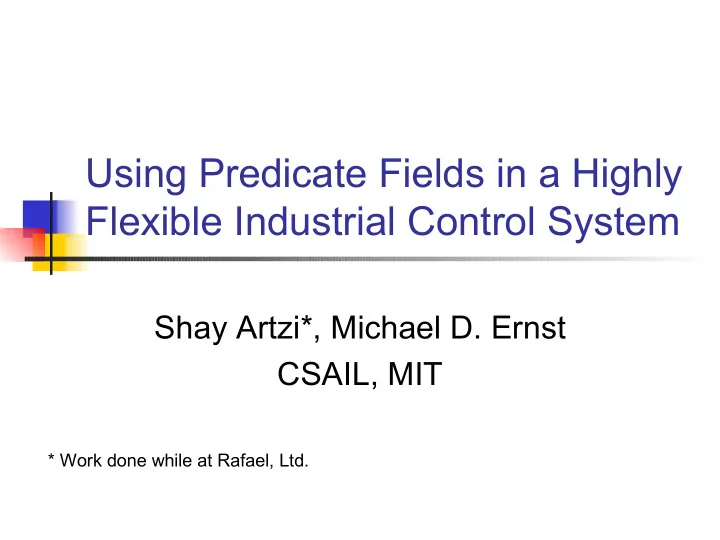

Using Predicate Fields in a Highly Flexible Industrial Control System Shay Artzi*, Michael D. Ernst CSAIL, MIT * Work done while at Rafael, Ltd.
Evaluating Predicate Fields Predicate oriented programming is a promising research idea that has never been evaluated in practice Dynamic classification of an object into subclasses: Predicate classes [Chambers et al. 93] Kea language classifiers [Mugridge et al. 91, Hamer et al. 92] Modes [Taivalsaari 93] Predicate Dispatch [Ernst el at. 98, Millstein 04] We successfully deployed them in an industrial application Conclusion: Increase software flexibility to handle changing and unknown requirements Simplify certain development task 2
Predicate Fields Example A predicate field is present or not, depending on the values of other fields First name: Shay obj:Reservation obj:Reservation Last name: Artzi -firstName -- “Shay” -firstName -- “Shay” … -lastName -- “Artzi” -lastName -- “Artzi’ No Ye Parking required : -parkingRequired -- true -parkingRequired -- false s - dates -licensePlate Dates :……….. License Plate : … -dates Dates :……….. 3
Implementation with Predicate Fields // Definition pred arriveWithCar (needsParking==true); class Reservation { ... bool needsParking; String licensePlateNum when@ arriveWithCar; } // Use Reservation r = new Reservation(); r.licensePlateNum = “44GT23”; //RUN-TIME ERROR r.needsParking = true; r.licensePlateNum = “44GT23”; //OK 4
Advantages of Predicate Fields Allow an object to change its structure during its life cycle Recover from user errors in user interface Emulate dynamic classification of an object into subclasses Expedite user interface development Fine-grained customization of objects 5
Outline Introduction Case Study: Experiment control system Predicate Fields Motivation Developer Experience Summary 6
Case Study: Experimental Control System System goal: define, control, execute, and examine results of experiments Experiment: Ordered instructions on a set of devices Control complex events and vast number of devices 7
Requirements and Design Non functional requirement: adaptability to physical hardware changes (new devices, device locations) MML language to create experiments Two-level system architecture Knowledge level: legal configuration of operational objects. Operational level: concrete model of the system. 8
Implementation 1 Development: Fifteen man years Written in Delphi IDE and the Object Pascal language Component based (COM/DCOM) ~100,000 lines of code In daily use Won several internal prizes Its deficiencies inspired the use of predicates in Implementation 2 9
Implementation 2 In development since 2002 in Visual Studio . NET and C# Currently in integration phase (adding controlled hardware) Five developers Implementation 1 functionality was subsumed in less than two years Controls more complicated hardware Uses predicate fields. 10
Implementation 2 tiers C# library Predicate Library Corresponds MML Developer: Interpreter Knowledge Level in Predicate Database Definitions U s i Using n g Developer: MML Operational Level Interpreter in C# and Editor Using User: Implementation Experiments in MML 11
Outline Introduction Case Study: Experiment control system Predicate Fields Motivation Developer Experience Summary 12
Predicate Fields Motivation in Implementation 2 Implementation 1 deficiencies were resolved using predicates: Tight coupling of persistent objects with their user interface Many custom made user interface forms Can’t change object types Inflexibility to some hardware changes 13
Motivation 1 Tight coupling Cause: MML statements which are persistent objects with UI representation had tight coupling with other components Problem: Changes to the structure of the MML statement required cross cutting modifications User Interface Object Database Objects Database components Viewers Connection Layer Example: adding a max_repeat field Solution: Dynamic objects. Structure and connections defined using predicates. Predicate fields carry the rest of the information Outcome: Changes to the MML statement data type can be easily done in one place (database) 14
Motivation 2 Many Custom Made UI Forms Cause: One UI form per MML statement type, and device type Problem: UI development and changes were costly Example: Adding a new measurement device type with a different number of channels Solution: Adopting .NET editing concept One adjustable properties form Object exposing properties to be edited PropertyGrid uses reflection to query a selected object structure Dynamic objects can be easily wrapped to expose properties Outcome: Homogeneous look and feel and reduced user interface development effort. 15
Editing concept example Setting Properties Defining an MML instruction 16
Motivation 3 Can’t Change Object Types Cause: The user is unable to change an object type in the MML UI Problem: losing mutual information of the new and the old object type Example: Changing an automatic statement to a manual one Solution: Using predicate fields to dynamically classify into subclasses. Outcome: Allowing objects to “switch type” while maintaining mutual information 17
Motivation 4 Inflexibility to Hardware Changes Cause: New device types with components that exists in the set of known devices required cloning information Problem: Introducing clones into the system. Maintenance complexity increase Solution: Using predicate fields to support fine grained combination of existing fields Outcome: More flexibility to new device types 18
Outline Introduction Case Study: Experiment control system Predicate Fields Motivation Developer Experience Summary 19
Definitions Modifications Developers making modification to the MML interpreter definitions: Modify the dynamic types (rarely) Modify predicates, fields and fields’ types (usually). Initially found to be difficult due to the library use and integral limitations 20
Limitations Declarative approach Far-reaching, system behavior depends on the metadata Developers need to master the knowledge level Type safety cannot be guaranteed Implemented as a library Incur performance overhead Software is harder to understand, less readable Poor UI (MML interpreter definitions were saved in database) 21
Developer Experience (after further use) Familiarity and ease Easily perform seemingly complex task Surprising uses (E.g. wizards for the knowledge level editor) Change in perspective toward designing the UI Dynamic type errors cause distrust Active interest from other development teams 22
Summary Used predicate fields in a large industrial application Developers find predicate fields useful Software flexibility is increased UI development costs were greatly decreased Lack of static type checking is a problem 23
Recommend
More recommend